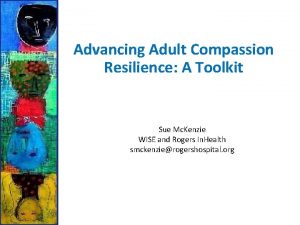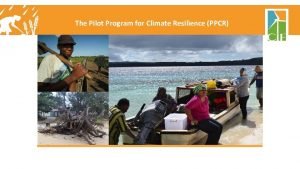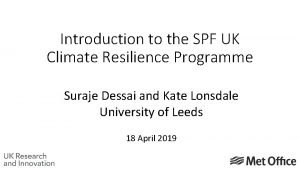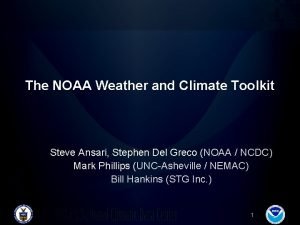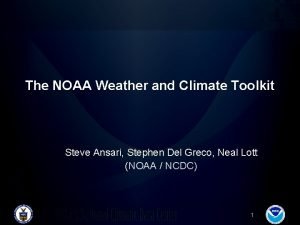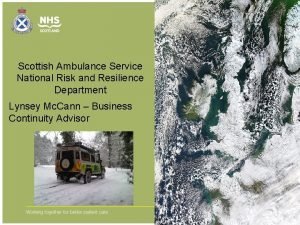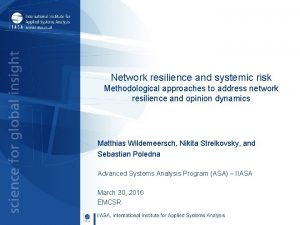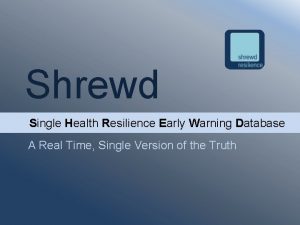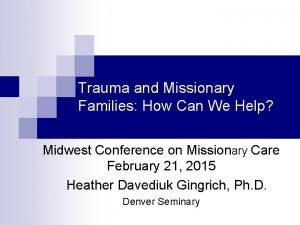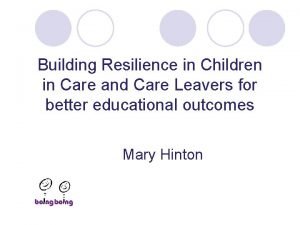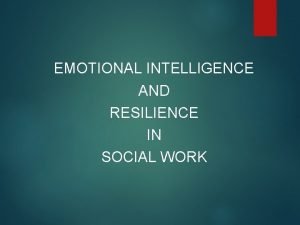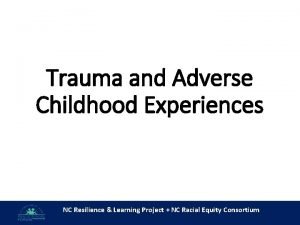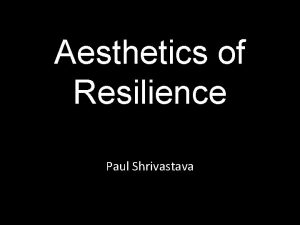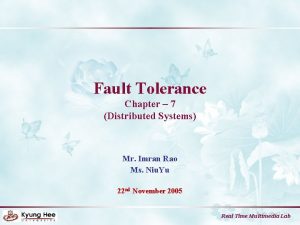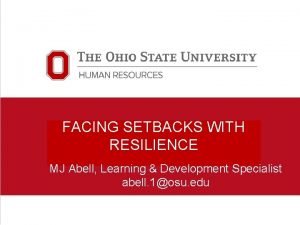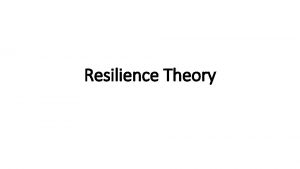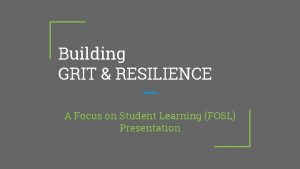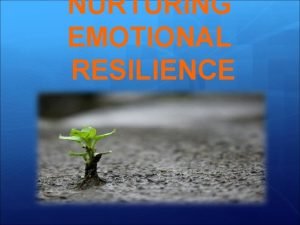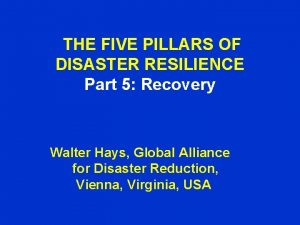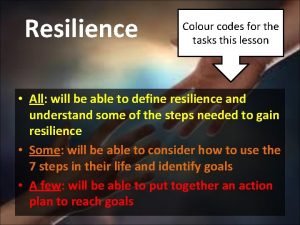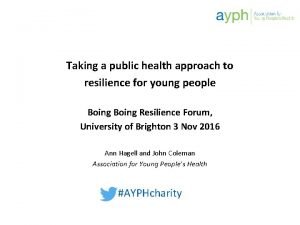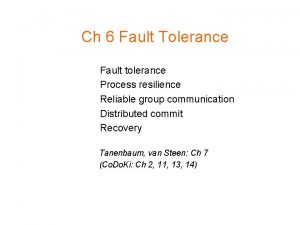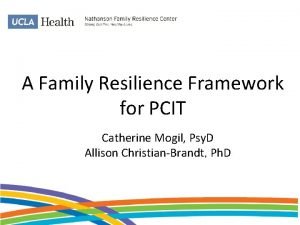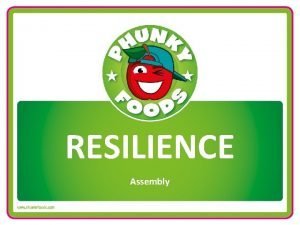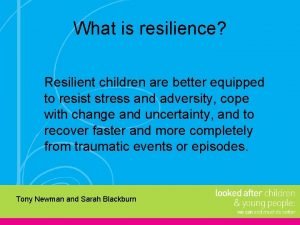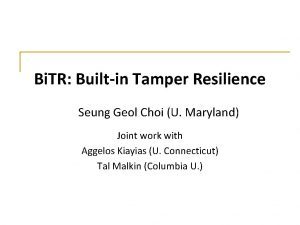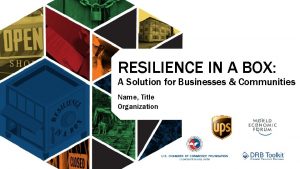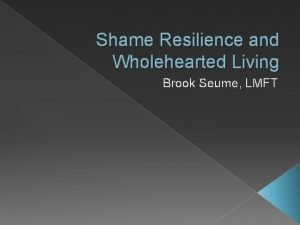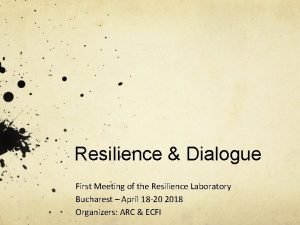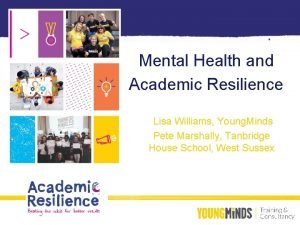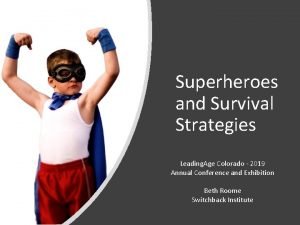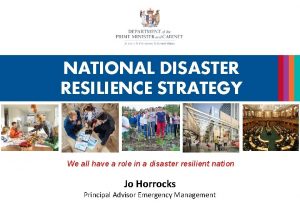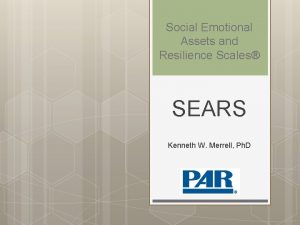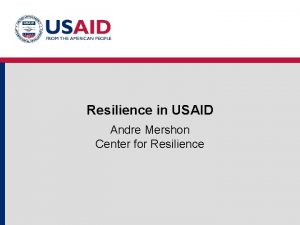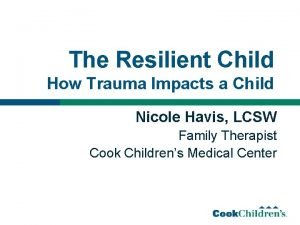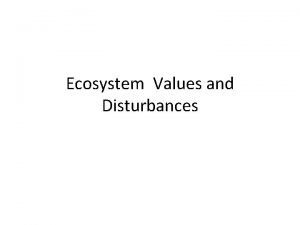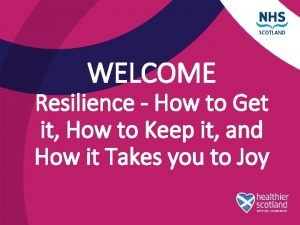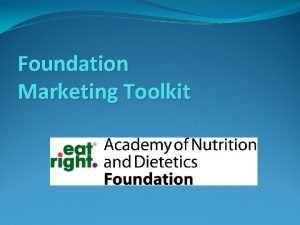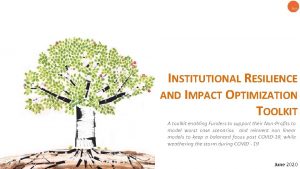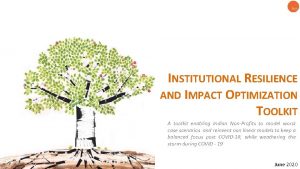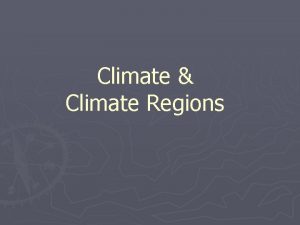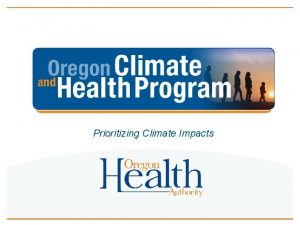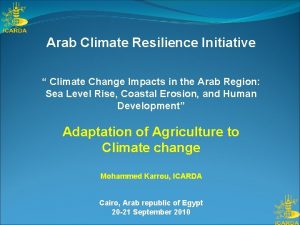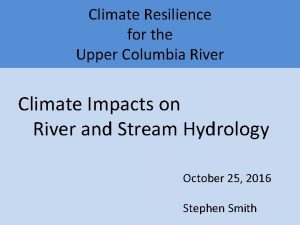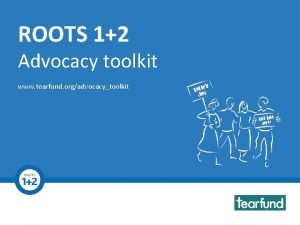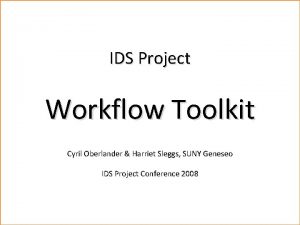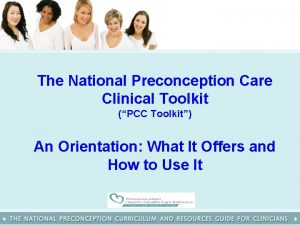U S Climate Resilience Toolkit Steps to Resilience



















































- Slides: 51

U. S. Climate Resilience Toolkit Steps to Resilience Overview toolkit. climate. gov David Herring, program manager NOAA OAR/Climate Program Office 301 -734 -1207 | david. herring@noaa. gov Overview for USTTI International Cohort November 1, 2017

Online at https: //toolkit. climate. gov 2

For people seeking help in building resilience 3

Resilience is the capacity to withstand or recover from a disruption (This concept is scalable from a single organism to entire systems — natural & human-built. ) 4

Did you know? Why should we care? What can we do about it? 5

Summary overview You are here in the St. R process Video orientation for each step Links to case studies showing others taking this step. Narrative text on each step of the St. R process Glossary & downloadabl e spreadsheet to help users capture notes Links to tools useful/releva nt to this step. 6

5 Steps to Resilience Step 1: Explore climate threats Did you know? • Identify the problem, including both climate & non-climate stressors and their impacts • Garner support and build your team — select people who are willing to give support and take action • Agree upon boundaries for your problem • Define key terms & use them consistently in group discussions 7

hazards & assets Wikipedia Commons drought & water resources

hazards & assets sea level rise & coastal habitats

hazards & assets floods and infrastructure

Do weather, climate &/or environment present a threat(s) to assets you value? Threats Assets 11

A framework for systems thinking Non. Climate Stressors Hazard Asset

A framework for systems thinking Future Change Non. Climate Stressors Hazard Asset

A framework for systems thinking Future Change Non. Climate Stressors Hazard Asset Action

A framework for systems thinking Future Change Non. Climate Stressors Indicator &/or Threshold Hazard Asset Action

Who should participate? Stakeholder Groups Candidates or Leads Contact Info Notes on Role(s) Representativ e (Names) Contact Info

What are your concerns? Key Assets or Weather or Resources Climate Hazards Past or Potential Impacts Climaterelated Stressors Non-Climaterelated Stressors Tipping Point(s)?

5 Steps to Resilience Exposure Sensitivity Potential Impacts Adaptive Capacity Step 1: Explore climate threats Step 2: Assess vulnerability & risk Vulnerability 18

How might we determine sensitivity? 1. Sector 2. Current and/or Expected Planning Area Stressors (Climate & Non-climate) 3. Conditions that 4. Potential Impact Contribute to or Consequence to Stressors Planning Area (Resources and Services Affected) 5. Projected Change in Stressors and Contributing Conditions 6. Degree of Sensitivity 19

How might we determine sensitivity? 1. Sector 2. Current and/or Expected Planning Area Stressors (Climate and Non-climate) Flooding Stormwater Management 3. Conditions that 4. Potential Impact Contribute to or Consequence to Stressors Planning Area (Resources and Services Affected) 5. Projected Change in Stressors and Contributing Conditions 6. Degree of Sensitivity Heavy precipitation, amount and timing of precipitation, tropical storms, and sea level rise and storm surge Damage to property and infrastructure in floodplain, impassable roadways, threat to human safety, and business interruption Recent increase in heavy precipitation in the region is already a concern, trend can be expected to continue Erosion and/or Landslides Runoff from heavy precipitation events, steep slopes Damage to property and infrastructure, impassable roadways, threat to human safety, and business interruption Recent increase in heavy precipitation in the region is already a concern, trend can be expected to continue High [only an examplesensitivity degree must be determined by each community team] Impervious surfaces Land use of best practices in developments Storm water fees and funding levels More storm water contributing to runoff and flooding Lack of infrastructure for managing storm water Increased development into the future can be expected Funding will likely continue to be a challenge Less funding for stormwater infrastructure upgrades 20

5 Steps to Resilience Exposure Sensitivity Potential Impacts Adaptive Capacity Vulnerability Probability of Occurrence Step 1: Explore climate threats Step 2: Assess vulnerability & risk RISK 21

Sources of information inputs Exposure Sensitivity Potential Impacts Adaptive Capacity Vulnerability Probability of Occurrence Legend: Federated data are available and useful Site specific information, knowledge, and evaluation required Required output to move on to next step RISK 22

How might we determine vulnerability? SENSITIVITY High Legend: Very High Vulnerability Medium Vulnerability Low Low Medium High ADAPTIVE CAPACITY

How might we determine risk? Probability of Threat High Very High Risk Medium Risk Low Low Medium Magnitude of Consequence High

5 Steps to Resilience Step 1: Explore climate threats Did you know? Step 2: Assess vulnerability & risk Why should we care? Step 3: Investigate options Step 4: Prioritize actions What can we do about it? 25

List & prioritize adaptation options Options = Feasible Comments Increase Resilience? = Potentially Feasible Economic Feasibility? Low Environ. Impact? = Not Feasible Ability to Implement?

For example… Options Comments Build levees Questions re budget & whether can prevent floods Build sea wall Beyond budget; will impact coastal ecology Managed retreat from shoreline Viable, but only as a partial solution Increase Resilience? Restore, Viable in all = Feasible protect categories= Potentially Feasible marshland Economic Feasibility? Neg. Environ. Impact? = Not Feasible Ability to Implement?

Overview… 28

Where can I get ideas about possible adaptation actions I can take to protect my valued assets?

For people seeking help in building resilience 30




Title & summary overview Share this on social media The ‘story’, introducing a protagonist, their climate challenge, and action(s) taken You are here in ‘Steps to Resilience’ CRT tool(s) featured in this case study CRT Regions & Topics relevant to this case study Whom to contact for more details

think in systems Asset > Waterfront Properties

think in systems Threat > Flooding Waterfront Properties

think in systems Very Heavy Precipitation Storm Surge Human development ^ Climate stressors ^ ^ Non-climate stressor Flooding Waterfront Properties

think in systems Global Warming Very Heavy Precipitation Sea Level Rise Population Growth ^ Future changes ^ Storm Surge Human Development Flooding Waterfront Properties

think in systems Global Warming Very Heavy Precipitation Sea Level Rise Population Growth Storm Surge Human Development Flooding Waterfront Properties Increase Insurance Rates ^ Action

think in systems Global Warming Very Heavy Precipitation Sea Level Rise Population Growth Storm Surge Change Bldg Codes Human Development Flooding Waterfront Properties Preserve Space in Floodplain Increase Insurance Rates ^ Actions ^ Improve Drainage Systems

think in systems Sea Level Rise Global Warming Very Heavy Precipitation Population Growth Storm Surge Human Development Flooding Indicator > Fewer Floods & Damages Waterfront Properties Change Bldg Codes Preserve Space in Floodplain Increase Insurance Rates Improve Drainage Systems

think in systems Sea Level Rise Global Warming Very Heavy Precipitation Storm Surge $ Saved from CRS Credits Mosquito Control ^ Co-benefits! Population Growth Fewer Floods & Damages Human Development Flooding Waterfront Properties Change Bldg Codes Preserve Space in Floodplain Increase Insurance Rates Improve Drainage Systems

5 Steps to Resilience Step 5: Take Action! • Implement plan • Monitor progress, watching for missteps or “mal-adaptations” • Iterate as needed • Share your story — both successes & are useful for others to learn • Decision point: has implementation of your plan increased climate resilience? 43


Expertise » Find Experts map 45



Our Funding Opportunities page presents a curated list of about two dozen grants offered by federal agencies & NGOs for municipalities & businesses seeking funds to help them recover from a disaster, or to build resilience to climate hazards.


http: //iri. columbia. edu/

http: //sedac. ciesin. columbia. edu/
 Compassion resilience toolkit
Compassion resilience toolkit Pilot programme for climate resilience
Pilot programme for climate resilience Uk climate resilience programme
Uk climate resilience programme Noaa wct
Noaa wct Weather climate toolkit
Weather climate toolkit Noaa weather and climate toolkit
Noaa weather and climate toolkit Climate change 2014 mitigation of climate change
Climate change 2014 mitigation of climate change Axial movements non locomotor
Axial movements non locomotor National risk ambulance
National risk ambulance Resilience pyramid
Resilience pyramid Emotional resilience in nursing
Emotional resilience in nursing Network resilience a systematic approach
Network resilience a systematic approach Shrewd resilience
Shrewd resilience What is psychological first aid
What is psychological first aid Resilience direct
Resilience direct I have resilience
I have resilience Emotional resilience in social work
Emotional resilience in social work Nc resilience and learning project
Nc resilience and learning project Resilience aesthetic
Resilience aesthetic Process resilience in distributed system
Process resilience in distributed system Bonnie benard resilience
Bonnie benard resilience Johannes volkelt empathy theory
Johannes volkelt empathy theory Resilience
Resilience Meaning of resilience
Meaning of resilience Building grit and resilience
Building grit and resilience Army resilience training slides
Army resilience training slides Resilience dental materials
Resilience dental materials Definition of emotional resilience
Definition of emotional resilience What are the 5 pillars of resilience?
What are the 5 pillars of resilience? Colour for resilience
Colour for resilience Boing boing resilience
Boing boing resilience Lbld meaning
Lbld meaning Process resilience in distributed system
Process resilience in distributed system Family resilience framework
Family resilience framework Haiku about spring 5-7-5
Haiku about spring 5-7-5 Resilience assembly
Resilience assembly Résilience définition
Résilience définition Resilience
Resilience Business resilience 101 workbook
Business resilience 101 workbook 10 guideposts for wholehearted living poster
10 guideposts for wholehearted living poster I have resilience
I have resilience Camp resilience
Camp resilience Modulus of toughness
Modulus of toughness Young minds resilience
Young minds resilience Leading age colorado
Leading age colorado National resilience strategy
National resilience strategy Social emotional assets and resilience scales pdf
Social emotional assets and resilience scales pdf Usaid center for resilience
Usaid center for resilience I have resilience
I have resilience Ecosystem resistance vs resilience
Ecosystem resistance vs resilience Pqa interview questions
Pqa interview questions Resilience meaning
Resilience meaning
